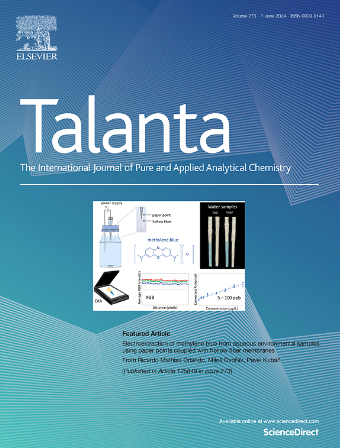An integrated and multifunctional homemade cell sensor platform based on Si-d-CQDs and CRISPR-Cas12a for CD31 detection during endothelial-to-mesenchymal transition
IF 5.6
1区 化学
Q1 CHEMISTRY, ANALYTICAL
引用次数: 0
Abstract
Endothelial-to-mesenchymal transition (EndMT) plays a crucial role in the initiation and progression of atherosclerosis and various disease processes. Cluster of differentiation 31 (CD31) is a significant marker in EndMT. Detecting CD31 is essential for early-stage monitoring of EndMT and diagnosing atherosclerosis. Herein, we propose a homemade electrochemical array sensor comprising four electrodes, applied for cell cultivation, electrical stimulation, and simultaneous electrochemical detection, offering a three-in-one approach for CD31 detection during EndMT. To enhance the analytical performance of the cell sensor, indium tin oxide/chitosan-MXene/polyaniline (ITO/CS-MXene/PANI) composites were synthesized. The synthesis process involved the polymerization of PANI on the surface of the CS-MXene-modified ITO electrode, resulting in the creation of highly biocompatible active sites for cell immobilization. Si-d-CQDs@acDNA-AptCD31-Fc, with exceptional photophysical and chemical properties, was integrated into the array sensor setup, which enabled the dual-mode detection of fluorescent and electrochemical signals in cultured cells. A CRISPR-Cas12a system was employed to cleave Si-d-CQDs@acDNA-AptCD31-Fc. Subsequently, the fragmented Fc molecules were enriched via electrochemistry to further amplify the electrochemical signals. Through the unique combination of programmable Si-d-CQDs@acDNA-AptCD31-Fc, the CRISPR-Cas12a system, and voltage enrichment, a novel “signal-on-off-super on” signal amplification strategy was developed. The cell sensor exhibited a wide linear range from 1 × 101 particles mL−1 to 1 × 106 particles mL−1 (R2 = 0.9912) and a detection limit of 4 particles mL−1. The proposed strategy presents a promising approach for developing CRISPR-Cas12a-based tools for detecting various stages of EndMT and opens a new window for dual-mode analysis applications.

求助全文
约1分钟内获得全文
求助全文
来源期刊

Talanta
化学-分析化学
CiteScore
12.30
自引率
4.90%
发文量
861
审稿时长
29 days
期刊介绍:
Talanta provides a forum for the publication of original research papers, short communications, and critical reviews in all branches of pure and applied analytical chemistry. Papers are evaluated based on established guidelines, including the fundamental nature of the study, scientific novelty, substantial improvement or advantage over existing technology or methods, and demonstrated analytical applicability. Original research papers on fundamental studies, and on novel sensor and instrumentation developments, are encouraged. Novel or improved applications in areas such as clinical and biological chemistry, environmental analysis, geochemistry, materials science and engineering, and analytical platforms for omics development are welcome.
Analytical performance of methods should be determined, including interference and matrix effects, and methods should be validated by comparison with a standard method, or analysis of a certified reference material. Simple spiking recoveries may not be sufficient. The developed method should especially comprise information on selectivity, sensitivity, detection limits, accuracy, and reliability. However, applying official validation or robustness studies to a routine method or technique does not necessarily constitute novelty. Proper statistical treatment of the data should be provided. Relevant literature should be cited, including related publications by the authors, and authors should discuss how their proposed methodology compares with previously reported methods.
 求助内容:
求助内容: 应助结果提醒方式:
应助结果提醒方式:


